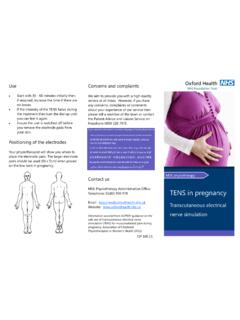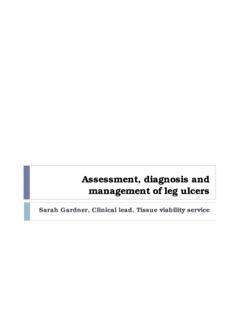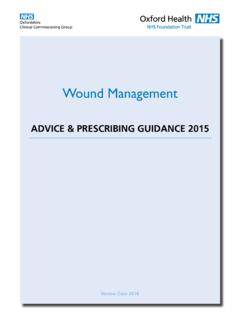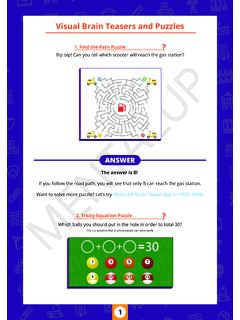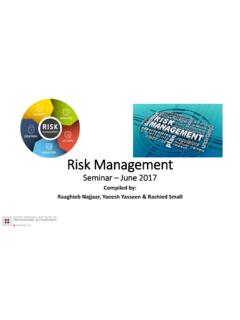Transcription of Sensory Processing - Oxford Health NHS Foundation Trust
1 Caring, safe and excellent Sensory Processing Children s Community Occupational Therapy Caring, safe and excellent Aims: awareness of the 8 Sensory systems. understanding of Sensory Processing . explore some practical ways to help children and young people with Sensory difficulties. Caring, safe and excellent The ability to register, discriminate, adapt and respond appropriately, both physically and emotionally to Sensory input from our bodies and the environment What is Sensory Processing ? Caring, safe and excellent Olfactory (Smell) Gustatory (Taste) Auditory (Sound) Visual Tactile Proprioceptive (Body Position) Vestibular (Movement) Interoceptive (Internal) 8 Sensory Systems Caring, safe and excellent Systems responsible for tasting and smelling Identification of safe vs. harmful Olfactory and Gustatory Caring, safe and excellent This is the system that identifies sights, and understands what the eyes see and prepares for a response.
2 Good ocular motor control is an essential skill for learning. Visual Caring, safe and excellent Two Types Touch Receptors: 1) Protective 2) Discriminative Receives sensations of pressure, vibration, movement, temperature and pain through the skin, and provides us with the sense of touch Tactile Caring, safe and excellent The system responsible for receiving and Processing sounds and therefore the sense of hearing and understanding what is heard. Auditory Caring, safe and excellent The vestibular system is our balance and movement sense. It tells us where our body is in relation to gravity, where it is moving and how fast. The movement receptors are located in the inner ear and are important for body posture, muscle tone and bilateral integration. Vestibular Caring, safe and excellent Our sense of Body Awareness Messages from muscles, joint capsules and tendons provide information about where our body is in space, how it is moving (direction, speed and force) without using vision.
3 It is proprioception that allows us to move our hands carefully without having to observe every movement. Proprioception Caring, safe and excellent Interoception Sensation related to physiological/physical condition of the body Detects responses that guide regulation hunger, thirst, heart rate, elimination, need for air, itch Caring, safe and excellent Motor Learning and Skill Acquisition Sensory INTAKE: Vision Smell Taste Hearing Balance Touch Proprioception Interoception brain : Automatic Processing of Sensory information ACTION: Child makes meaningful motor, language, behaviour or emotional response which enables participation Motor learning process enhanced by Cognition Attention Motivation Caring, safe and excellent Sensory Processing Difficulties Difficulty responding appropriately to Sensory input; Traffic Jam in the brain Inappropriate or problematic behavioural, motor, or adaptive responses after Sensory stimulation At least 1 in 20 children have Sensory Processing Difficulties Not currently a medical diagnosis Caring, safe and excellent What does SPD look like?
4 The symptoms of SPD vary greatly depending upon what senses are affected, how those senses are affected, and the severity of the condition. 3 main categories Caring, safe and excellent Difficulty regulating or "fine tuning Sensory info (volume control) 1- Over-responsiveness (hypersensitivity) - Predisposition to respond too much, too soon, or for too long to Sensory stimuli most people find quite tolerable Sensory Modulation Disorder Caring, safe and excellent SOR - behaviours Aggressive, impulsive or defiant when overwhelmed Avoids sensations Irritable, fussy, moody Unsociable, avoids group activities and has trouble forming relationships Excessively cautious, afraid of new things Upset by transitions or unexpected change Caring, safe and excellent Caring, safe and excellent Caring, safe and excellent Caring, safe and excellent Sensory Modulation Disorders 2- Under-responsiveness (hyposensitivity)
5 Predisposition to be unaware of Sensory stimuli, to have a delay before responding, responses are muted or responds with less intensity compared to the average person, not even to pain or extreme hot or cold. Caring, safe and excellent SUR - behaviours Passive, quiet, withdrawn Difficult to engage in conversation or other social interactions Easily lost in own fantasy world Apathetic and easily exhausted Excessively slow to respond to directions or complete assignments Poor inner drive, uninterested in exploring Caring, safe and excellent Caring, safe and excellent Caring, safe and excellent Sensory Modulation Disorders 3- Sensory Craving - Driven to obtain Sensory stimulation, but getting the stimulation results in disorganization; and does not satisfy the drive for more Caring, safe and excellent SC - behaviours Constantly wants control over every situation Doesn t wait turn, constantly interrupts Angry or explosive when needs to sit still or stop activity Intense, demanding, hard to calm Prone to create situations others perceive as bad , dangerous or disruptive.
6 Caring, safe and excellent ALWAYS on the go! Caring, safe and excellent Caring, safe and excellent I LOVE messy play! Caring, safe and excellent Caring, safe and excellent Sensory Discrimination Specific qualities of Sensory stimuli are perceived and meaning given to them Understanding accurately what is seen, heard, felt, tasted, smelled Detection of similarities or differences amongst stimuli do I hear cat or cap (tuning or clarity) Caring, safe and excellent What Alerts or Calms You? Everybody is different What alerts or calms you may do the opposite to someone else Does it Really Matter? The key to providing the correct Sensory environment is observation of what children seek and what they avoid. Caring, safe and excellent What can you do to help Increase your knowledge of why your child is behaving the way they are Become a Sensory detective Try and increase child s self awareness of how they are feeling and why Help the child to self regulate Change the environment Caring, safe and excellent Caution The strategies we are about to discuss are based on a neuroscience theory base but currently do not have sufficient research evidence to support their effectiveness.
7 There is limited case by case evidence that some of these strategies work for some children. Caring, safe and excellent Environment management Predictable, structure and organisation are words that describe the environment in which children thrive. These children have difficulties organising themselves and recognising which aspects of the environment are important. They feel relaxed, comfortable and are able to function when they are in environments that provide structure and organisation (Murray-Slutsky, 2000) Caring, safe and excellent PROPRIOCEPTION Activities that send strong messages to the brain about the child's body position (proprioception) have an "organising" effect on the nervous system. Proprioceptive input helps the child to reach a "just right" state of alertness so they can focus and learn. It is important to include regular proprioceptive activities for children with Sensory Processing difficulties.
8 Caring, safe and excellent Examples of Heavy work If in doubt about which Sensory approach always try Heavy Caring, safe and excellent Deep Pressure Input Stamping feet Hat Hug Lift Caring, safe and excellent One-to-one teaching Preferential seating at front of classroom Provide proprioceptive deep pressure input before & after a noisy event as this is calming/ organizing. Wear snug/tight clothing which can have a calming effect Strategies - Auditory Caring, safe and excellent Auditory Chew gum, suck on sports water-bottle or eat chewy or crunchy foods to help increase concentration in noisy environment. If necessary remove child from sound or make a quiet corner that is away from the noise. Caring, safe and excellent Auditory Verbal or visual warning before loud sounds occur (such as fire alarm drill) Rhythmic ( white noise or quiet music with a steady beat)
9 Head phones with no music in class, ear defenders Caring, safe and excellent Teeth Cleaning Toothpaste and brush in mouth 2 different textures Use minimal toothpaste, bicarbonate based stop gagging Use an electrical toothbrush provides deep pressure and vibration Apply deep pressure to cheeks with both hands on cheeks blow up cheeks and squash flat Play tongue games before brushing count teeth on left side with tongue, put tongue in cheek etc Blowing and sucking games Caring, safe and excellent Dressing Heavy work/deep pressure before changing Use comfortable clothes consider fabric, length of sleeves Tolerance of seams wear undergarments leggings/vests Cut labels out Wash clothes in unscented products Seamless underwear/soft clothing www. Caring, safe and excellent Hair Washing/Brushing/Cutting Sit child firmly on lap, squeeze child between your knees Place hands on head, apply gentle but firm pressure wear a tight hat prior to help desensitise Counting whilst doing the task Get child to scoop and pour water Fold flannel over eyes Tip head back to pour water over Firm touch when massaging shampoo Soft hair brush- tangle teaser Hold top of hair whilst brushing out tangles Caring.
10 Safe and excellent Child hates baths / showers Do resistive activities before to provide deep pressure Encourage child to wash own body / face Use large sponge and rub firmly Fragrance free soap Use hand held shower head increased control Use large towel to wrap and firmly dry afterwards pat firmly or leave to dry Firm massage if putting on cream Run bath before child enters the room Caring, safe and excellent Toileting Moist toilet roll / wipes Keep visual and auditory stimulation to a minimum Toilet seat might be too hard, padded toilet seats May feel unsecure if feet not touching the ground use a step Caring, safe and excellent Sleep Strategies Before bed: Massage/ back rubs Bear hugs In bed: Heavier blanket Bed tent Sleeping bag Swaddle Caring, safe and excellent Sleepwear try out different pyjamas all in one (without feet in), fleecy, silky, check for seam (wear inside out) remove labels High cotton count sheets for smoother surface Positioning of the bed bed close to wall so child can squeeze their body against the wall Wake up Alarm clocks sounds, music, light Firm wake up hugs Use electric toothbrush to wake up mouth Caring, safe and excellent Food Avoidance behaviours Overreaction to.
